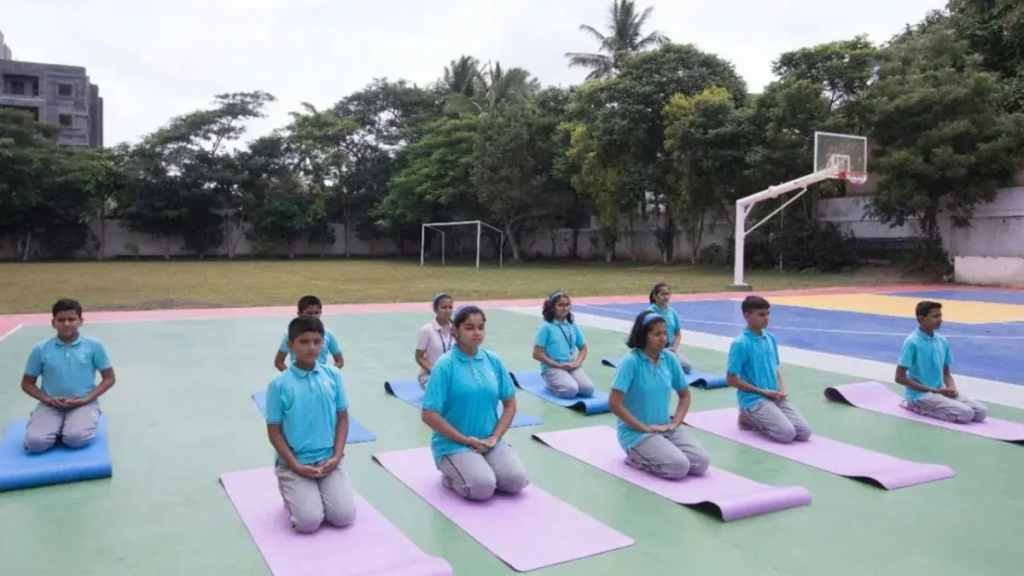Yogandhra, Andhra Pradesh’s flagship school yoga programme, has brought together nearly 60 lakh students, teachers, parents, and school committee members in a powerful show of collective wellness and unity. Organised by the School Education Department across 61,266 schools, Yogandhra was launched as part of the lead-up to International Yoga Day and has now become one of the largest school-level yoga initiatives in the country.
The month-long campaign, which began on May 21, culminated on Saturday with large-scale yoga demonstrations held simultaneously in government and private schools across the state. With active involvement from the entire school ecosystem, Yogandhra went beyond just a symbolic event — it became a statement of Andhra Pradesh’s commitment to holistic education and student well-being.
Focusing on Holistic Development in Schools
The idea behind Yogandhra was not limited to a single day of celebration. It was designed as a sustained effort to promote yoga as part of everyday school life. The School Education Department aimed to introduce students to yoga’s physical, mental, and emotional benefits in a practical, engaging way.
“Mass participation across thousands of schools highlights our commitment to student well-being,” said B Srinivasa Rao, State Project Director of Samagra Shiksha. He emphasised that yoga helps students stay mentally alert, emotionally balanced, and physically fit — all of which are essential for overall growth.
Beyond Students: A Whole-Community Movement
Yogandhra was unique in its inclusive approach. Parents, teachers, and members of school management committees were encouraged to join the sessions. In many schools, the yoga demonstrations became a community event, with families participating alongside children in school grounds, auditoriums, and open fields.
This collective participation helped spread awareness about the importance of physical and mental health and brought communities closer in a shared goal — nurturing healthier, happier children.

Building Lasting Habits Through a Month-Long Campaign
Unlike one-time events, Yogandhra was structured to run for an entire month. Daily yoga sessions, wellness talks, and group activities were conducted to help students develop consistency and awareness. The idea was to shift yoga from being an occasional activity to a regular part of students’ routines.
Age-specific routines were introduced so that children of all grades could participate meaningfully. Teachers received guidance and training on conducting sessions, and support materials were distributed to ensure consistency across schools, even in remote areas.
Aligned with National Education Goals
The Yogandhra programme also reflects the goals of India’s National Education Policy (NEP) 2020, which encourages schools to promote holistic learning. Physical education, emotional resilience, and mental wellness are key components of the NEP, and initiatives like Yogandhra directly support that vision.
The School Education Department has also indicated that yoga and mindfulness practices will continue to be a part of school life in Andhra Pradesh even after the International Yoga Day celebrations, ensuring long-term impact on student health and concentration.
A Blueprint for the Nation
Yogandhra’s massive scale and successful execution show what can be achieved when wellness is made a collective priority. By involving schools, families, and communities, Andhra Pradesh has created a model that other states can look to.
As India strengthens its identity as the birthplace of yoga and a promoter of global wellness, grassroots movements like Yogandhra ensure that the benefits of yoga begin with the youngest citizens — the students who will shape the future.
Conclusion
Yogandhra is more than a yoga programme. It’s a movement that celebrates health, mindfulness, and unity. By involving 60 lakh participants across over 61,000 schools, Andhra Pradesh has proven that when schools prioritise holistic well-being, the entire community rises with them.
ALSO READ
WACE Curriculum Brings Global Education Standards to Indian Schools
Kashmiri Students Choosing Iran for Medical Studies
A decade after NALSA, trans students still await inclusion on Indian campuses